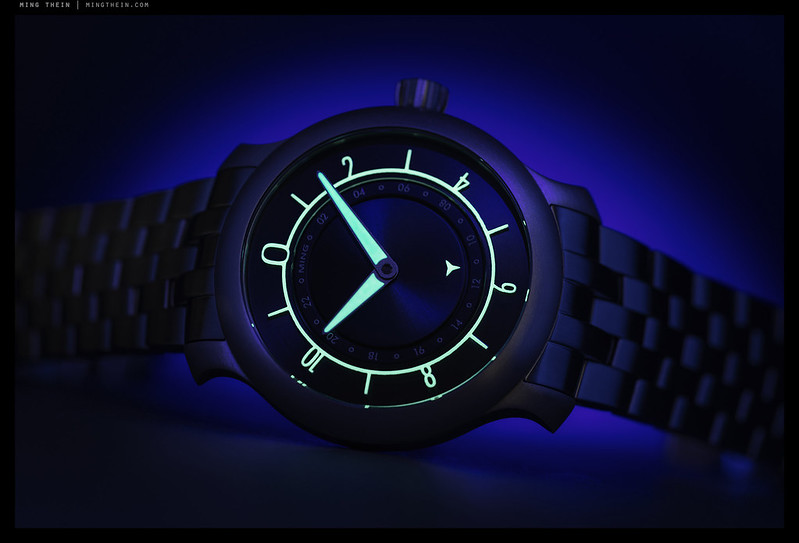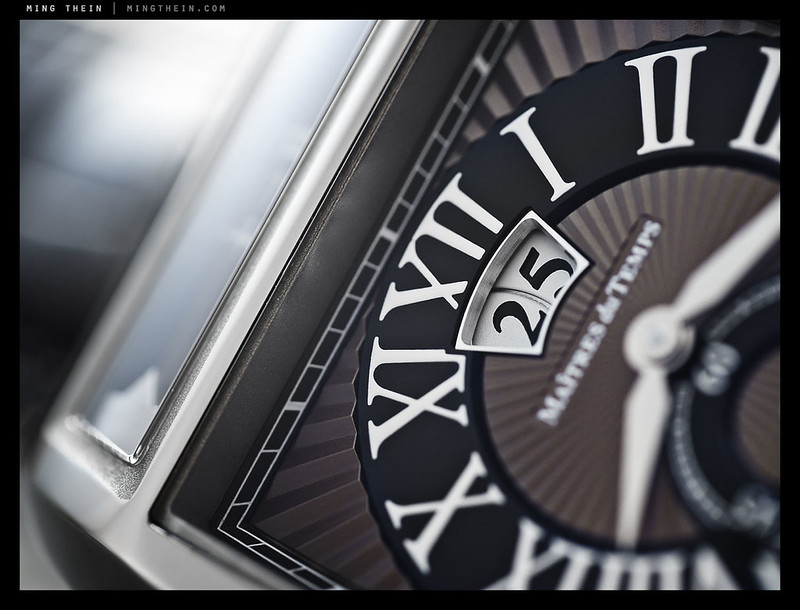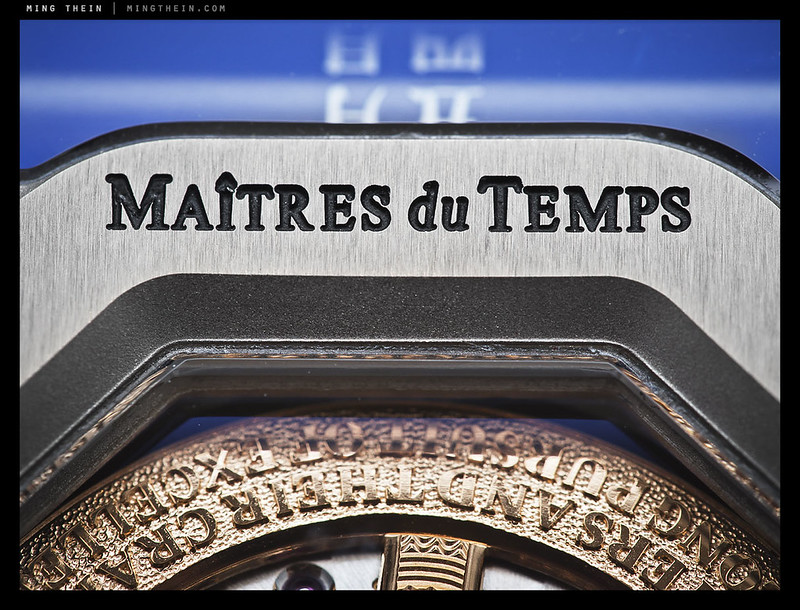The most challenging types of watch to design is where there are already rigid expectations set by the genre – pilot, diver etc. – to go outside this requires either not meeting functional requirements, or producing something that takes some acclimatisation by the market. You want to avoid being different simply or the age of being different as this inevitably leads to issues of design longevity/maturity as well as functional compromises. Our interpretation of a dive watch has had the longest and most painful gestation to date – with conceptual explorations starting in late 2017, not long after the 17.01 was launched. It’s taken us nearly two years to make something we were happy with, and in the end – we have also decided not to go to series production because it came too late in the brand’s overall design cycle. Even if we committed now, we wouldn’t see product until the end of next year at the earliest, by which time other launches with our second generation design language would have taken place and leaving the Abyss feeling a bit out of place.
Off topic: Why I started making watches, part II

The unexpected: 19.01, November 2017
Our group wondered if there were alternatives. We started looking into independents, and for me personally, those who would be willing to entertain serious customisation without breaking the bank; this meant compromising on the movement side, but as it turns out there were still interesting alternatives to be had. Ochs und Junior took the challenge and gave me very simple (read: reliable) annual calendar and high accuracy moon phase watches, but more than that, forced me to adapt the design to be coherent with the immutable parts (cases, complication locations and indications, production limitations). Until this point, I was still designing; evolving both my movement conceptualisation skills and aesthetics. By now, I’d developed a coherent design language and over 50 watches (including movements) on paper; these watches would represent the first baby steps towards seeing them come to life. But first, the ornamental complexity had to go; design would be reductive instead of additive. It was an interesting process that forced me to really identify and simplify critical elements required for time telling and identifiable stylistic cues down to their bare minimum. The Simpleton and Celestial were the product of those experiments, and it’s probably clear that design elements from both made it into our subsequent watches.
Off topic: Why I started making watches, part I

The MING family, as of March 2019
It’s a fair question, and one I’ve been asked frequently enough to properly explain myself somewhere, for the record. I suppose it isn’t just something you pick up on a whim one day, nor is it something that even if you had a burning desire to do – can easily begin by submitting a CV to a headhunter. Watchmaking, in its purest definition, is a vocation – not a profession. You physically have to make something, and in the process of doing so (from scratch, of course) understand everything from engineering to metallurgy to physics to aesthetics. It is the kind of masochistic intellectual pursuit undertaken successfully by only the most dedicated, the most skilled, or the most masochistically insane. I am not a watchmaker in the pure definition, nor am I dextrously skilled, but I am fairly dedicated and probably also insane. After all, eight years ago (has it been that long?) I did quit the top of the corporate game to start all over again as a photographer. And now, not having learned my lesson, history repeats.
OT: first anniversary!

With some relief and a big exhalation of breath, it seems the horological venture has survived the first year; let me tell you it hasn’t been easy given we’re effectively trying to start something in an industry that doesn’t have any ecosystem in our country, competing directly against much better funded and experienced players. There have been no end of surprises – both good and bad – for the moment culminating in a nomination for a GPHG* prize for our flagship 19.01. We’re celebrating with a watch (of course) or more specifically two (one is good, more is better) variants of the automatic GMT 17.03 – both in the ever popular blue, with revised and refined dial and hands, and an experiment – because experimentation is what keeps us going. I heat blued 25 grade 2 titanium cases with a blowtorch, resulting in something rather special (and something I wanted to do with my own Ochs und Junior some time ago, but we had the wrong alloy). We made 125 of the regular titanium cased blue dial, and 25 of the Ultra Blue – unfortunately the Ultra Blue sold out within about an hour of announcement, and we have a very long wait list**, but the Blue is available right now at www.ming.watch. I leave you with specifications after the jump and the customary images; experimented with some new lighting techniques in this set, too. MT
*Grand Prix de Horologerie de Geneve, which is effectively the Oscars of the watch world.
**I seem to be very good at shooting myself in the foot when it comes to estimating demand and edition sizes.
Photoessay: Design goals
Regular readers probably know that I have more than a passing interest in all things horological; firstly as an aspiring collector, then a photographer (this is what motivated me to begin, to be the story of another article), then a low-budget collector, and fortunately, somebody who has access to the industry through client relationships and options that might not be available elsewhere. Eventually, I realised that the temptation to design my own was far too strong; finding the right collaborator proved less easy, but I eventually realised that dream (more detailed story here). It is, unfortunately, both an addictive and frustrating process: inevitably, once you’ve lived with any design for any length of time, you start to appreciate what works and get frustrated by what doesn’t. It’s even more frustrating when you have ideas you might want to try, and know that you can (somewhat) easily execute them. Some CAD and some sitting time later, the design has matured and you are making some phone calls. The trick is not to overdesign: it is easy to make something that’s too fussy and just doesn’t work.
Horological-photoessay: One of your own
Today’s subject is a somewhat unusual one, and an esoteric one even for the horological enthusiasts in the audience. It’s not often that a creative sees the whole product gestation process through form design to photography to consumption; either it happens at the very small and private scale, or you work for Apple (or the like) in in a senior capacity. It takes a certain environment for that to happen. For me, this is probably the fifth or sixth time; several watches for various companies, and of course the MTxFF daybag. This design is a one-off for myself, made by a little company in Switzerland called Ochs und Junior that specialises in such customisations. I wanted something unusual, wearable on a daily basis, and visually interesting: that would have a bit of a chameleon personality depending on light (both direction and quantity). I think this is pretty clear in the images. This is an odd series from a purely photographic standpoint, too: though every set of images I post is subject to some degree of self-curation, here it really doesn’t matter what anybody else thinks of object or images: neither are really for mass consumption 🙂 MT
I wrote the full story behind this watch here, for Quill and Pad, in much greater detail (and probably more than most readers would want to know). Images were shot with a D810, 85 PCE and speedlights, and processed with Photoshop/LR Workflow III. I cover the basics of watch photography in a series of three articles, starting here.
On Assignment: Retouching, and the difference between amateurs and pros…

Maitres du Temps Chapter Three in white gold. (Larger version) There are panels at 6 and 12 that drop down into the dial and retract to uncover day/night and second time zone indicators; there’s a moonphase indicator at 4.30, date at 2 and small seconds at 8. Like all watches designed and made by famous independent ACHI members – this one is the offspring of Kari Voutilainen and Andreas Strehler – if you have to ask the price…
An image like this requires a surprising amount of work: I’ve already talked about the mechanics of lighting horological images in this three-part series (beginning here). To be honest, I originally intended to photograph the set up and other b-roll for another on-assignment post, but the simple reality is that I’m usually so busy on the shoot that I just don’t have the time. Instead, I’m going to talk about the amount of work that goes in behind the scenes.
Film diaries: Watches and a Hasselblad

Digital contact sheet of the negs.
I’ll admit that deep down, from the day I decided to buy the Hasselblad, I’d harboured a deep, masochistic desire to do this. During previous evaluations of medium format for my main commercial subjects, it didn’t really fit the bill: too difficult to achieve the degree of magnification required for watches, and digital medium format wouldn’t give me the width I needed for architectural work. It’d also be overkill for food photography in this country, given the current state of affairs*.
*I recently had a large corporate client ask for a portfolio and quote, then turn around and give the job to another photographer who quoted less and said ‘here, copy’. The results were crude because of harsh lighting and repetitively boring subject placement, but I suppose if they can’t tell the difference…perhaps I’m the one who’s got unrealistic expectations?
But hey, on film, for fun and in the spirit of creative experimentation, why not?
Watch photography with the Olympus OM-D, and thoughts on its use as a backup system

The Maitres du Temps Chapter Two Tonneau China special edition.
For a system to be able to serve as backup, it must fulfill one important function: the ability for me to continue working with it and delivering images if my main system should fail for any reason. And it should be able to cover all genres of what I shoot, without too many workarounds or compromises. The obvious choice would of course be to buy two of the same camera, but a) where’s the fun in that, and b) sometimes it’s also useful to have a different camera system to give you other shooting options not available from your primary.
For the past couple of months, I’ve been shooting with the Olympus OM-D for most jobs which do not require special purpose lenses (e.g. tilt shifts) or huge resolution; the Nikon D800E of course covers everything else. What I’ve found so far is that from a usability and image quality point of view, the camera has no problems delivering the goods consistently; the only exception being a peculiar lockup problem that only happens if you use the Fn1 button to zoom into an image after shooting, then hit the protect button if you’re in the screen with the zoom toggle slider on one side. Unfortunately that does seem to be part of my workflow, but I’m learning to avoid it.
The biggest question, in my mind, was whether the system was a viable alternative to the D800E for doing watch work – rather important, given that this is the majority of what I do commercially. I acquired a Panasonic-Leica 45/2.8 Macro Elmarit (yes, a review is in the works) for this purpose. Suffice to say – the lens isn’t the limiting factor at all, it’s pretty darned awesome (and one of the better macro lenses I’ve used, actually).
Although Olympus does have a wireless flash system (FL36R, FL50R and FL500R) which is IR-triggered like Nikon and Canon’s systems, I wasn’t about to buy another set of speedlights, and certainly not about to carry them around along with the primary system, too. Fortunately the Nikon SB900s I use have a SU4 optical slave trigger mode – with manual flash power, of course. I used this and manually set the output levels. Yes, it’s much slower than using iTTL and dialing in adjustments directly through the camera, but it works.
All in all, as you can see from the images here, I think the results are pretty darned good – my client didn’t say anything about the file quality, or lack of it; the OM-D’s files interpolated very cleanly to 25MP and their required resolution.
Depending on what I shoot, I’ll carry the OM-D body and 12mm and 45mm macro lenses, or just the 45; the 20/1.7 rides along as a body cap. One nice thing is its ability to use the Zeiss ZF glass I’ll normally carry for my D800E via an adaptor, so I don’t even have to carry the 45 and 20mms if I’ve got the 50/2 Makro-Planar and 21/2.8 Distagon.
One note of caution – during my recent Hong Kong workshop, the camera decided to stop working in a very humid environment (light rain, probably 90-95% humidity) and didn’t come back to life again until being dried out in air conditioning and with a few blasts from a hair dryer for good measure – so they’re probably not as well weather sealed as they claim. It continued to work intermittently for a few days afterwards, with menus self-navigating (as though one of the buttons was shorted out) before working normally thereafter. Odd. MT
The Olympus OM-D in various configurations is available here from B&H and Amazon.
____________
Visit our Teaching Store to up your photographic game – including Photoshop Workflow DVDs and customized Email School of Photography; or go mobile with the Photography Compendium for iPad. You can also get your gear from B&H and Amazon. Prices are the same as normal, however a small portion of your purchase value is referred back to me. Thanks!
Don’t forget to like us on Facebook and join the reader Flickr group!
Images and content copyright Ming Thein | mingthein.com 2012 onwards. All rights reserved
Photoessay: The Jaeger-LeCoultre Reverso Latitude
Not a commercial job, but one of those watches I’d personally encountered once, a long time ago in 2003, but was unable to afford at the time. Nevertheless, it left an impression on me, and from the time I did have the money to spare, I’ve been hunting one down. The problem is that they were very rare to begin with – I believe just 150 pieces were made – and with a very unique and beautiful dial; consequently, they’re rarer than hen’s teeth, and I’ve only ever seen one offered for sale new, and a grand total of zero on the secondary market. On my last trip to the factory, I did ask on the off chance that there was an unsold piece or two in the stockroom; there wasn’t.
On the way back to Kuala Lumpur, I passed by the watch shop in the airport without a second thought; after all, I was late for my flight at that point and had to run. Something compelled me to take a quick look; in a display case hiding behind a pillar was the very watch I’d been searching out for years. Some hasty negotiation ensued – it was obviously a new old stock piece bearing the marks of rough handling, but still sold as new with warranty – they were nice enough to give me a hefty discount and an additional strap. My wallet was suitably lightened, and I just managed to make my flight.
It’s a small watch by today’s standards, but is very thin (and of course mechanical) and pairs perfectly with a suit. The original Reversos were double sided with a blank metal case back, ostensibly to protect the watch while its wearer played polo; these days they’re either used as a second dial for complications, or a canvas for an engraving or art piece. I’m thinking of getting a Hokusai wave enameled on the back, but I’m in no hurry; these things are like tattoos; once it’s on, it’s for life.
If this story isn’t an example of fate and patience, I’m not sure what is. It seems that good things do come to those who wait. MT
This series shot with a Nikon D800E, SB900s, AFS 60/2.8 Micro and Zeiss ZF.2 2/50 Makro-Planar.
____________
Visit our Teaching Store to up your photographic game – including Photoshop Workflow DVDs and customized Email School of Photography; or go mobile with the Photography Compendium for iPad. You can also get your gear from B&H and Amazon. Prices are the same as normal, however a small portion of your purchase value is referred back to me. Thanks!
Don’t forget to like us on Facebook and join the reader Flickr group!
Images and content copyright Ming Thein | mingthein.com 2012 onwards. All rights reserved






















